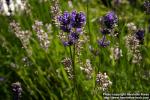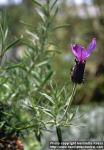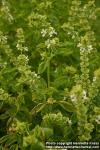Lavandula.—Lavandula.

 Preparations: Spirit of Lavender
- Compound Tincture of Lavender
Preparations: Spirit of Lavender
- Compound Tincture of Lavender
Related entry: Oleum Lavandulae Florum (U. S. P.)—Oil of Lavender Flowers
The flowers of Lavandula vera, De Candolle (Lavandula spica, var. a. Linné; Lavandula officinalis, Chaix; Lavandula angustifolia, Ehrhart).
Nat. Ord.—Labiatae.
COMMON NAMES: Lavender, Lavender flowers.
ILLUSTRATION: Bentley and Trimen, Med. Plants, 199.
Botanical Source.—Lavandula vera, of De Candolle, is a small shrub, generally 1 or 2 feet high, but sometimes growing to even 6 feet. The leaves are oblong-linear or lanceolate, entire, opposite, sessile, and, when young, hoary and revolute at the edges. The flowers are of a lilac color, small, in terminal, cylindrical spikes, formed of interrupted whorls of 6 to 10 flowers, each whorl with 2 minute bracts. The corolla is tubular, 2-lipped, upper lip large and 2-lobed, lower lip 3-lobed. The floral leaves are rhomboid-ovate, acuminate, membraneous, all fertile, the uppermost shorter than the calyx. Stamens 4, declinate; anthers reniform, 1-celled; style slender; stigma bilobate (L.).
History and Chemical Composition.—Lavandula vera inhabits southern Europe and north Africa, growing in dry, sterile soils in mountainous and other sunny elevations. It is largely cultivated in the United States, flowering in July and August. It is subject to a disease, which can only be avoided by not allowing the plants to grow too closely together. The whole plant is aromatic. The flowers are the parts used; they are gathered shortly after their appearance, or before fully expanded, usually in June and July, and carefully dried. They have a rich, peculiar fragrance, which is retained long after drying, and a strong, bitter, aromatic, somewhat camphoraceous taste. Their properties are yielded to alcohol or ether. They contain volatile oil (see Oleum Lavandulae), resinous matter, tannic acid, a bitter principle, and woody fiber. The recent flowers yield from about 1.2 to 1.6 per cent of the volatile oil.
Action and Medical Uses.—Lavender is atonic, stimulant, and carminative. It is seldom given in the crude state, but in its official preparations, which see. Colic is said to be occasioned by the infusion if immoderately used. Lavender fomentations are occasionally employed in painful local affections. The infusion is prepared with 1 drachm of the flowers and 1 pint of water. Prof. Scudder considered lavender the child's stimulant, preferring the tincture of the oil (℥ii to alcohol Oj).
Related Species.—Lavandula spica, of De Candolle, is more dwarfish and more hoary than the Lavandula vera. Leaves oblong-lanceolate, somewhat spatulate, entire, much narrowed at the base, hoary on both sides. Spikes somewhat interrupted. Bracts linear-subulate, Shorter than the calyx. This plant is not used in medicine, but yields what is called oil of spike, much used in the preparation of artistical varnishes and by porcelain painters. The chief constituent of this oil is cineol.
 Lavandula stoechas, Linné.—This small shrub, the flowering spikes of which are known as French or Arabian lavender is found in the countries bordering on the Mediterranean. They bear small-stalked, deep-purple, small flowers, having a camphoraceous, pronounced aroma.
Lavandula stoechas, Linné.—This small shrub, the flowering spikes of which are known as French or Arabian lavender is found in the countries bordering on the Mediterranean. They bear small-stalked, deep-purple, small flowers, having a camphoraceous, pronounced aroma.
 Ocimum basilicum, Linné, Basil, Sweet basil.—This herb is an annual, belonging to he Labiatae, and indigenous to Africa and Asia, in the tropical portions, and often cultivated in gardens. It has a cooling, balsamic taste, and a strongly aromatic, agreeable odor. It contains a small amount of tannin and a volatile oil. This plant is employed in some sections as a flavoring herb in cooking, and in southern South America, the fresh juice is employed to expel worms. It has been used in mild nervous disorders. The oil is nervine and carminative.
Ocimum basilicum, Linné, Basil, Sweet basil.—This herb is an annual, belonging to he Labiatae, and indigenous to Africa and Asia, in the tropical portions, and often cultivated in gardens. It has a cooling, balsamic taste, and a strongly aromatic, agreeable odor. It contains a small amount of tannin and a volatile oil. This plant is employed in some sections as a flavoring herb in cooking, and in southern South America, the fresh juice is employed to expel worms. It has been used in mild nervous disorders. The oil is nervine and carminative.

